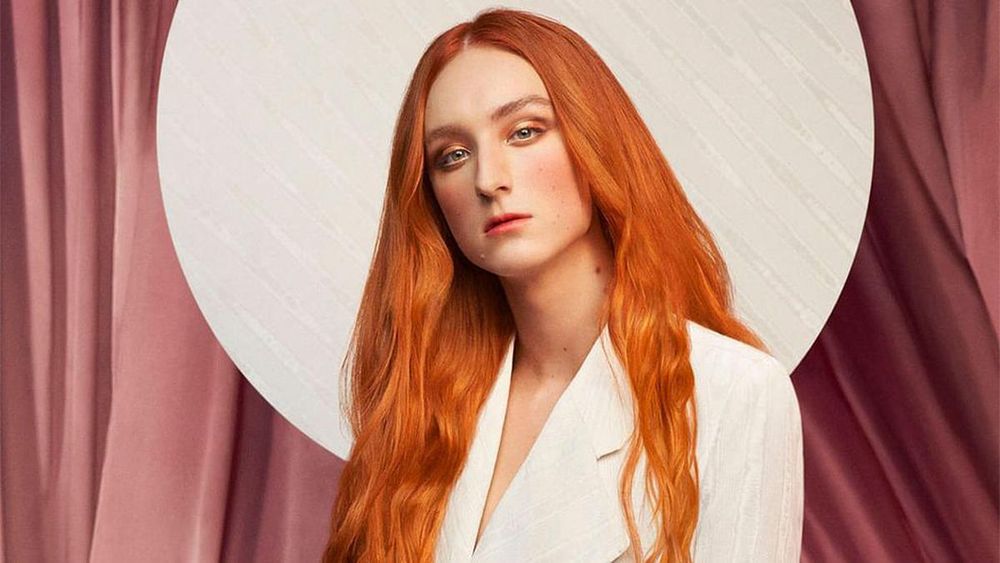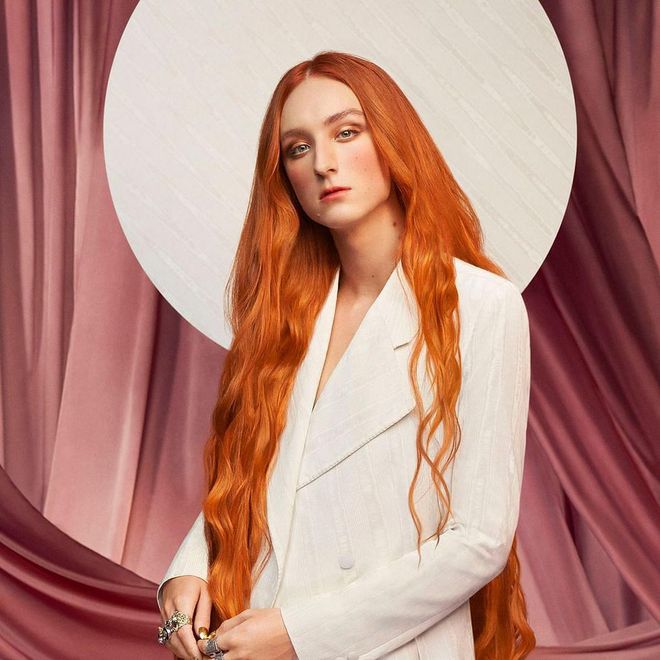Designer Harris Reed On Creating Genderfluid Makeup With MAC
"The collection for me really embodies this idea of not only fluidity, but complete and utter self-expression."


Photo: Courtesy
Designer Harris Reed On Creating Genderfluid Makeup With MAC
Although you might not know Harris Reed by name (yet), you undoubtedly know their romantic, glam-rock designs. At just 24 years old, the London-based fashion designer has been worn by Harry Styles, Rihanna, and Selena Gomez on magazine and album covers. From here—and with that kind of internet clout—it would be easy for a new designer to retreat into the hazy and unreachable world of red carpets, high fashion, and editorial spreads, bringing their aesthetic with them.
Related article: Zoë Kravitz Just Dropped A Second Lipstick Collab With YSL
Yet, today, Reed is debuting a new and very accessible makeup collection with MAC Cosmetics inspired by their own genderfluid identity and designer style. MAC x Harris Reed will include new MAC Lipstick, Cream Color Base, Eyeshadow, and Eye Kohl in glitzy metallics, pink, and nudes. Prices range from US$21 to US$35.
Related article: Miranda Kerr’s Skin Care Secret Is Mushroom
Move fast, though—the collection is a limited edition online exclusive, and the clock is ticking if you factor in the many fans eager to connect with the designer dressing all their favourites. Ahead, Reed walks BAZAAR.com through the new makeup collection, glam rock, and creating genderfluid products.
Can you tell us about the MAC x Harris Reed collection?
The collection for me really embodies this idea of not only fluidity, but complete and utter self-expression. Nothing is in a tube and nothing has a brush. It's really all very much like an artist palette; it's meant for your fingers, it's meant for men, women, non-binary, every individual to feel completely comfortable to be able to play with.
Reference points come from anywhere from Studio 54, the ‘70s—a time of complete androgyny and glam rock and decadence and fabulousness. And then also, looking still within that theme, a completely different world [of] Rococo, more of this idea of androgyny back then. In paintings, it's so effortless and just kind of had this beautiful blending. So very much pulling in this old world, Rococo, men in makeup, really kind of lounge-y fabulousness, and then juxtaposing but also sitting beautifully within Studio 54 and the ‘70s.
I read how your own genderfluid identity helped inspire this collection. How did it feel to take that identity and translate it into the physical form of makeup?
I think, you know, I don't look at what we did as a product—it's more like another extension of who I am and for me, I could not think of a better way to translate this idea of fluidity than makeup. As a fashion designer, I'd love to basically translate this idea and break down barriers of gender by putting [out] clothing that can be worn on any body; it’s not about being male or female, it's really about expressing yourself and what you feel on the inside and outside. But with makeup, it’s so much more multifaceted and also so much more accessible. You can have a lipstick or an eyeshadow palette in your back pocket and literally, while you get on the bus, change the way you look within seconds. And that's not just how you look, that's also how you're expressing your gender, your identity, the way you want to experiment and be free with your own will power.
You mentioned fluidity in particular—why is it important to you to spotlight fluidity both in this collection and in your own designs?
In all my work, fluidity takes the forefront because I think we're living in a time where everything is still so gendered and everything is still so boxed in. People are always like, ‘We're moving forward, brands are doing, like, unisex!’ And it's like, it's not really moving forward, it's just creating another category. For me, fluidity embodies this idea that you're breaking down every category. So for this line, I really stress that word fluidity because this is not makeup for men, this is not makeup for women, this is not makeup for non-binary individuals. This is makeup for everyone, and that fluidity aspect is what I want to drill into into the world because, you know, now that we have Biden, now that there’s so much positivity going on—I hope I'm not being overly political—I feel like it's hopefully a way to bringing back this idea that you can be who you want to be and not have to get scared and hide away. So fluidity is a constant drilling point for me, especially within this line with MAC.
“Gender neutral” is blowing up in beauty marketing right now. In your opinion, as someone who is genderfluid, what makes a beauty product truly fluid? What captures that identity?
It's a great question because it's so tricky. I think for me and my friends, it’s so obvious when a brand's literally just slapping something on, because I feel like there's no paper trail, or no actual proper representation of what that word fluidity means. A lot of times it's very transparent—and I'm not going to call companies out—when people slap on a bit of a ‘fluid’ or a ‘unisex’ thing, and they don't actually choose to collaborate with a person who represents that community or choose the right representation within the models and casting to reflect that.
I think what's great about MAC is that MAC is, from when I was super young, the brand that was putting makeup on men before that was being advertised as a thing. They were the people that were pushing boundaries in the beginning.
Related article: Dior Just Launched 75 New Refillable Lipsticks
I feel like I see a lot of “gender-neutral” makeup or products and they’re like... pink and blue. What inspired the color story of the collection?
The colour story really came from a place that felt completely authentic and legitimate to me and the fact that I believe we learn from the past. I've always been so deeply fascinated by history. I think if I didn’t do fashion, besides being a queer activist I'd really maybe be a historian. I think we've learned from the past, we learn from history, and when I was developing the packaging, I wanted to really represent this old world nuance.
Obviously, I know the palette’s in kind of like this soft pink. I love the colour pink. I like to be a bit tongue in cheek with it, I think that's the English side of me. I like to take something that is so specific and gender-specific and just take it and make it my own. I was like, we're gonna choose the colour pink and really just make it this colour that is universal and mix that with the old world charm.
Let's talk about glam rock; it can often be rooted in vintage, but your designs are giving it a very modern edge. What is the future of glam rock?
I've always loved glam rock. I’ve always said we need more people like David Bowie. At a time like right now, a lot of things can either look very the same, or brands are doing things—or musicians are doing things—that sometimes don't feel authentic. I love glam rock because there’s a level of grit and more importantly a level of authenticity that I think shines through all the glitter and the glam and the flares and the ruffles.
Related article: Victoria Beckham’s New “Clean” Mascara Is Here
I look at all those things, the flares, the ruffles, as points of reference of someone expressing themselves at the most heightened, most authentic, most outrageous part of themselves. So I think for me, glam rock, it's almost like fluidity. Obviously it’s different, but they go hand in hand because it's your most extreme version of yourself. You are expressing who you are in the most heightened, over the top, fabulous way. Like you said, I really try to be modern in my designs, but I still try to keep that nuance and push it to the limit. Be the person who doesn't fit the mould. Be the person that doesn't fit the box. That’s where I see glam rock coming back into what we do and our daily lives and within fashion—being referenced more as a way of being than just a specific style.
This interview has been edited and condensed for clarity.
This article originally appeared on Harper’s BAZAAR US.